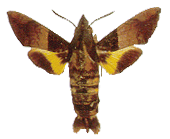|
Macroglossum passalus Drury
Sphinx passalus Drury, 1773, Illustr. exot. Ins., 2: 52.
Rhamphoschisma rectifascia Felder, 1874, Reise Ost. Fregatte Novara,
Lep.,
t. 75.
Macroglossum passalus Drury; Rothschild & Jordan, 1903: 664.
|

Macroglossum passalus
(.85
natural size)
|

Macroglossum
passalus (Sphingidae); Hong Kong
(M.J. Bascombe)
|
Diagnosis.
This and the next species have a dark brown to black basal half to the
forewing with a straight (or slightly concave in faro) distal boundary;
beyond this the wing is pale grey, grading darker towards the apex, though
with a paler lunule on the costa subapically. In faro the dorsum of thorax
and abdomen is greener. The basal half of the hindwing below is much more
suffused with yellow scales in passalus. M. faro is much larger.
Geographical range. Japan, Oriental tropics to Sundaland.
Habitat preference. The few specimens have been taken in montane
localities: at 1618m on Bukit Retak, Brunei; at 900m in lower montane
forest on the limestone G. Api, Sarawak.
Biology. The larva was described by Bell & Scott (1937). The head is
dull green. The body is pale yellow with faint blue transverse lines and a
dark blue dorsal stripe over the abdominal segments, edged with pale blue.
There is a similar lateral stripe running between two large black spots on
T2 and two black spots on A10. There is a broad, blue-spotted, black
dorsolateral stripe. The horn is pale blue, ringed black basally. The Hong
Kong larva is illustrated above .
Recorded host-plants (Bell & Scott; Miyata, 1983; Bascombe, in litt.)
are: Daphniphyllum (Daphniphyllaceae); Photinia (Rosaceae).
<<Back
>>Forward <<Return
to Contents page
|

